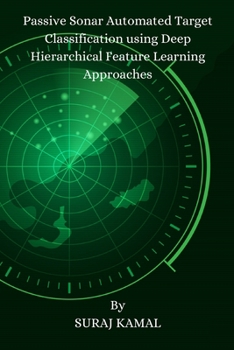Passive Sonar Automated Target Classification using Deep Hierarchical Feature Learning Approache
As most regions of the globe are under constant surveillance by commercial, weather monitoring, military satellites and ground-based observatories over the entire electromagnetic spectrum, it is virtually impossible to hide any objects or activities that emit radiation or are exposed by it. However, high electrical conductivity of the ionic seawater attenuates electromagnetic waves, including visible light, to a significant extent so that any attempts to probe the ocean with the modality may offer little or no success. Thus three-quarters of the entire earth surface is shrouded from the otherwise pervasive eyes of electromagnetic radiation, which makes it a perfect place for strategic operations; nevertheless, it is rather hostile for human activities. Underwater vessels such as submarines that operate under clandestine are hard to observe and pose a severe threat to national security. Hence, effective detection of their presence, location, and identity is crucial for safeguarding. The mechanical perturbations created primarily by the vessel engine, crew activity or even water flowing over the hull can propagate significantly long distances without much attenuation through the water medium. Thus acoustics is the known best modality till date to detect underwater targets at relatively long tactical ranges. Far before, from the days of satellites or electromagnetic surveillance, this has been well understood. Although long shorelines offer Exclusive Economic Zones (EEZ) and sovereign rights over the sea and enormous resources to a nation, it becomes an Achilles heel during times of conflict. The dichotomy of control over the seas or to defend from it significantly affects the concurrent naval power projection tactics and strategies. Due to the strategic and commercial importance of SONAR and underwater acoustics, research in these areas has gained considerable interest during the past few decades. The discipline covers the study of a broad range of underwater acoustic phenomena and their applications to surveillance, detection and oceanography 1, 2, 3]. 1.1 Early Developments In 1490, Leonardo da Vinci wrote 'If you cause your ship to stop, and place the head of a long tube in the water and place the outer extremity to your ear, you will hear ships at a great distance from you'. The humble beginning of the long marched journey of the study on underwater acoustics started then and has leapt over during the twentieth century and continues to be a growing field of knowledge, with many significant applications. Hydro-acoustics was born as an exclusive naval technology during the early 1900s due to the increased threat from the undersea fleet on surface transport. The emergence of unrestricted submarine warfare
Customer Reviews
Rated 5 starsA Teacher in itself
I took AP Calculus course last year and at the end of the year I found this book while searching for a reliable AP Calculus help. The best thing i've gotten from the book is the fact that in the AP Calculus test of 2002, there were some multiple choice questions that actually were based on the Calculus III stuff. I am glad that i perused this book to the fullest extent. no wonder i got the best grade on my ap result. This...
0Report













